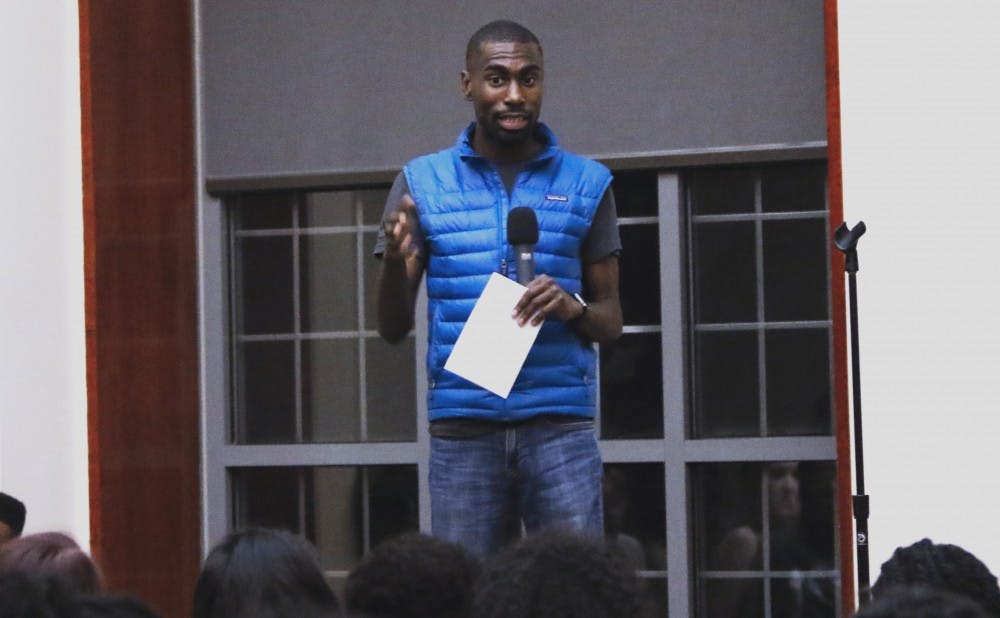The first of two Thursday events featuring activist and educator DeRay Mckesson focused on the tensions and similarities between the current Black Lives Matter movement and the Civil Rights movement of the 1950s and 60s.
Mark Anthony Neal, professor of African and African American studies, moderated the discussion—"Generations: The Timeless Fight for Equality"—between Mckesson and Charlie Cobb, Duke activist-in-residence of the Student Nonviolent Coordinating Committee legacy project. The discussion was the first event of the day hosted by the Black Student Alliance, with the second being a Real Talk event in the evening. BSA President Henry Washington, a junior, introduced the speakers and outlined the goals for the event.
“We wanted to be able to talk about the tensions and the overlaps between the work of the Civil Rights movement and the work of Black Lives Matter,” Washington said.
The initial discussion centered on the different forms of representation that activist movements can take. Much of the dialogue about the Black Lives Matter movement has taken place on social media—the iconic hashtag of the movement is unique to the social media outlet Twitter.
Neal compared the Civil Rights movement to “analog” activism while noting that the Black Lives Matter movement is “quite literally a digital movement.”
Despite the different channels of activism, the motivations for joining activist movements have not changed much, Cobb explained.
“People engage in activism because something triggers the activist in them,” he said, highlighting that for Black Lives Matter, the trigger was police brutality against black men—whereas the Civil Rights movement was triggered by segregation.
Mckesson said for him, activism started with his work as an educator, noting the he began his career in the school systems both as a teacher and an administrator at the hiring level.
The events in Ferguson, Mo., last Fall after Michael Brown's death were what spurred Mckesson to take on a more active role in the Black Lives Matter movement.
“It was in the moment that I got tear-gassed [in Missouri] that I realized this is not the America I know, and I am willing to do whatever I have to do to fight to get that America back,” he said.
It took seeing that no one was coming to stop the atrocities in Ferguson that made the movement so powerful because it meant that any progress had to be entirely from the ground up, Mckesson explained.
This realization also prompted Mckesson to leave his job in the school system to make a more permanent impact on the movements he was a part of.
“I am not any more free when I make $110,000 than I was when I made $45,000,” Mckesson said, explaining that working toward a goal of equality was far more fulfilling for him than any salary could be.
Cobb and Mckesson also compared the ways in which the activist movements spread their messages.
For Mckesson, social media is a way of communicating with others in the movement outside of the oppressive systems that limit their communication.
He explained that without Twitter, it would have been easy for people to deny that there was a movement going on in Ferguson, especially because of the no-fly zone.
“It was illegal to stand still, so we had to march. We had to keep moving.” Mckesson said.
Although digital social media was decades away from being created during the Civil Rights movement, Cobb explained that there were still ways of utilizing media to widen nets of communication.
“Our social media was the newspapers and the television.” Cobb said, highlighting specifically the role of black newspapers.
Although there are similarities in how activists in both movements communicated their thoughts, with social media, activists have more direct control of the message they send and no longer need to rely on reporters, Mckesson noted.
“We became our own storytellers,” he said.
Neal said that many consider Black Lives Matter to be a “leaderless movement” and because the media looks for one figure to turn to when covering impactful social movements, the media is unsure how to deal with a space without a leader.
This can lead to difficulties in streamlining the message of the Black Lives Matter movement, Mckesson explained, noting that there are difficulties that come with managing the message of the media with any activism movement.
Much of the criticism levied against Black Lives Matter activists from older and more established activists from previous movements is an exact reflection of the criticism that was once levied against them, Cobb said.
He noted that one of the biggest things supporters of the Civil Rights Movement had to learn was that the issues of racism in America were entirely systemic. Despite the successes of the movement, the institutions in the country still facilitate White supremacy, he said.
“That system is still there, grinding people down,” Cobb said.
The event concluded with questions from the audience.
“This is a wonderful opportunity to have the kind of generational dialogue that because of the wonders of technology we don’t always have the opportunity to have,” Neal said.
Get The Chronicle straight to your inbox
Signup for our weekly newsletter. Cancel at any time.

